
Bradypodion is one of six genera of chameleons within the "true" or "typical" chameleons. They are native to southern Africa, and are sometimes collectively called South African dwarf chameleons. Some other small chameleons from eastern and central Africa are occasionally placed herein, but this is probably in error and not followed here. See also Systematics below and Kinyongia and Nadzikambia.
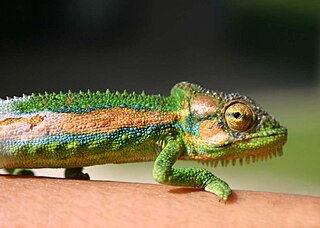
The Cape dwarf chameleon is a chameleon native to the South African province of the Western Cape, where it is restricted to the region around Cape Town.
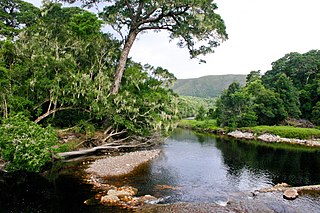
The Knysna–Amatole montane forests ecoregion, of the tropical and subtropical moist broadleaf forests biome, is in South Africa. It covers an Afromontane area of 3,100 square kilometres (1,200 sq mi) in the Eastern Cape and Western Cape provinces.
The Zululand dwarf chameleon is a species of lizard in the family Chamaeleonidae. It is also known as the Qudeni dwarf chameleon. It is endemic to South Africa.
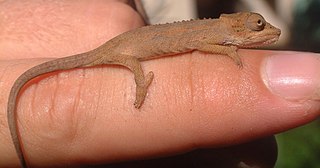
Setaro's dwarf chameleon is a species of lizard in the family Chamaeleonidae.

Smith's dwarf chameleon or the Elandsberg dwarf chameleon is a species of lizard in the family Chamaeleonidae endemic to South Africa. It is one of the few chameleons that uses its color-changing ability to actively camouflage itself.

The Transvaal dwarf chameleon is a chameleon native to South Africa, where it is found in forested areas of Mpumalanga and Limpopo provinces. It is also known as the Wolkberg dwarf chameleon, after the Wolkberg range.

The Transkei dwarf chameleon or Pondo dwarf chameleon is a chameleon endemic to the Eastern Cape Province of South Africa.

The Robertson dwarf chameleon, also known as the Little Karoo dwarf chameleon, is a chameleon in the genus Bradypodion. It is found in the dry Fynbos and Renosterveld shrub vegetation, in the centre of the Western Cape province, South Africa.
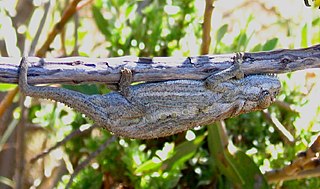
The Swartberg dwarf chameleon is a species of chameleon endemic to South Africa.

The black-headed dwarf chameleon is a lizard of the family Chamaeleonidae endemic to KwaZulu-Natal, South Africa. It is also known as the KwaZulu dwarf chamaeleon and Durban dwarf chameleon.
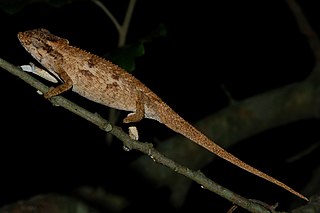
The Kentani dwarf chameleon occurs in coastal area of the Eastern Cape, South Africa.

Bradypodion ventrale, the southern dwarf chameleon, occurs in the Eastern Cape, South Africa. It is also known as the eastern Cape dwarf chameleon. It is a relatively large species of dwarf chameleon, reaching lengths of 14 cm (5.5 in). It has a very prominent casque on the back of its head and a long, beard-like throat crest. It lives in dense thickets and shrub, and is usually very difficult to spot because of its colouring. It adapts very well to living in suburban gardens, but domestic cats – being introduced predators – will usually kill all chameleons in the immediate area. Consequently, one should not bring chameleons into a garden which is frequented by cats. It gives birth to litters of between 10 and 20 babies in the summer.

The Drakensberg dwarf chameleon occurs in the Drakensberg, South Africa, between the latitudes of 27°45′ and 29°15′. Bright green dwarf chameleons found in the Drakensberg south of 29°15′ are now known to be more closely related to the Natal Midlands dwarf chameleon and may yet be described as a separate species. Picture

The Namaqua dwarf chameleon or the western dwarf chameleon occurs in beach vegetation, along the west coast of South Africa and Namibia.

The Karkloof Forest is situated in the Karkloof Nature Reserve, 22 km north of Howick, KwaZulu-Natal, South Africa.
The Karoo dwarf chameleon is a chameleon native to South Africa. It is about 14 cm (6 in) long, mostly colored grey and brown, sometimes olive. The thin skin around the throat is yellow, and it has conical scales along the spine.
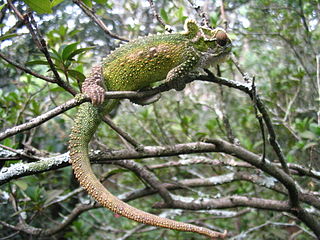
The Natal Midlands dwarf chameleon is a chameleon native to woodland habitat in the inland Midlands area of the South African province of KwaZulu-Natal.
Kinyongia carpenteri, commonly called Carpenter's chameleon or the helmeted chameleon, is a species of chameleon, a lizard in the family Chamaeleonidae. The species is native to central Africa.

The Mlanje Mountain chameleon is one of two species in the genus Nadzikambia. It is a plesiomorphic, small chameleon from the Ruo Gorge forest on Mount Mulanje in Malawi.




















